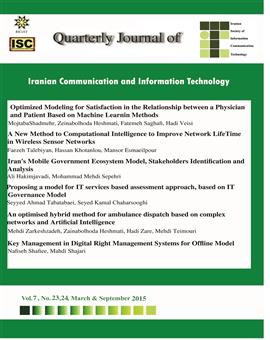-
-
List of Articles
-
Open Access Article
1 - Optimum modeling of patient satisfaction with the doctor based on machine learning methods
- شادمهر Zainabolhoda Heshmati Fatemeh saghafi Hadi Veisi -
Open Access Article
2 - Presenting a method based on computational intelligence to improve energy consumption in smart wireless sensor networks
faezeh talebian حسن ختن¬لو منصور اسماعیل¬پور -
Open Access Article
3 - Iran's companion government ecosystem model, analysis and recognition of the main players
ali hakimjavadi محمدمهدی سپهری -
Open Access Article
4 - Providing a model for evaluating information technology services based on an approach based on information technology governance models
seyyed ahmad tabatabaei سید کمال چهارسوق -
Open Access Article
5 - Providing an optimal method for dispatching an ambulance based on complex networks and artificial intelligence
مهدی زرکش زاده Zainabolhoda Heshmati Hadi Zare Mehdi Teimouri -
Open Access Article
6 - Key management in digital rights management systems in offline mode
nafiseh shafiee مهدی شجری
-
The rights to this website are owned by the Raimag Press Management System.
Copyright © 2017-2026







